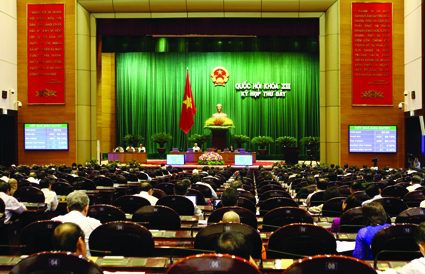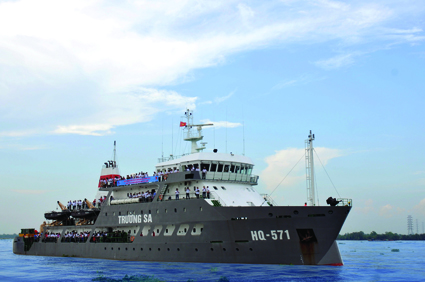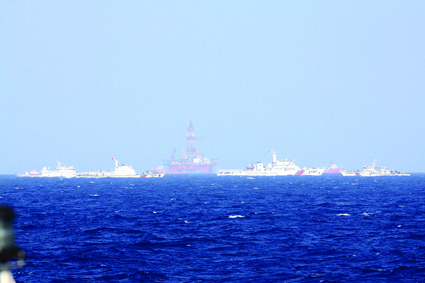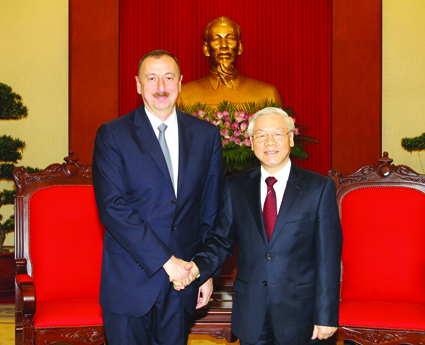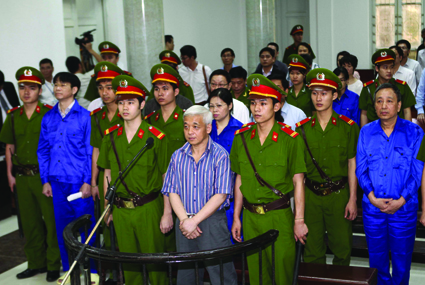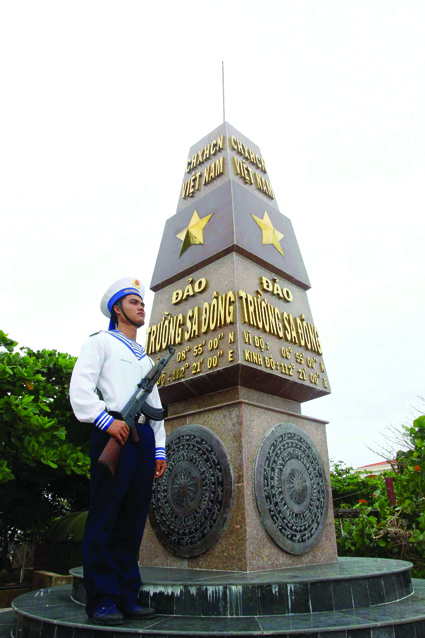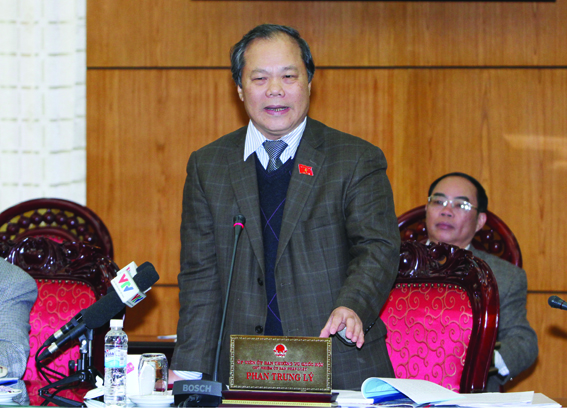Le Thanh Khuyen
Deputy Director General
General Department of Land Administration
On May 15, 2014, the Government released a massive decree which details a number of articles of the Land Law. With 103 articles arranged in 10 chapters, this Decree, numbered 43/2014/ND-CP, ensures conformity with the Constitution, the Land Law and relevant laws.
This article features the major contents of the Decree.
1. The Decree provides in detail a number of contents related to land use planning, such as responsibilities of sectors and administration levels for determining land use demands and proposing projects in the process of formulating land use master plans or plans; systems of land use norms in provincial- and district-level land use master plans; consultation on land use planning; order and procedures for appraisal and approval of provincial- and district-level land use master plans and plans; conditions on organizations and individuals providing consultancy on land use planning; and responsibilities of People’s Committees of all levels for reviewing sectoral and local master plans and plans to make sure that they are compliant with land use master plans and plans approved by competent authorities.

2. In order to restrict the late and wasteful land use in investment projects and to strcitly control the use of land for project implementation, the Decree sets out specific conditions for land allocation or lease by the State and change of land use purpose. Under the Decree, related ministries must be consulted on the implementation of foreign-invested projects in border and coastal areas or on islands. Other conditions are related to land areas used by projects, deposit payment, financial capacity and compliance with the land law of persons who are allocated or leased land or permitted by the State to change land use purpose for implementation of investment projects.
3. The Decree specifies force majeure circumstances and the point of time for counting the land use term extension of 24 months for investment projects that fail to put land into use or delay the land use.
Force majeure circumstances that may affect the land use schedule of investment projects include natural disasters, environmental catastrophes, fires, epidemics, wars and other circumstances as decided by the Prime Minister.
Regarding the disclosure of information on projects that commit violations of the land law related to land use schedule, the Decree stipulates that provincial-level People’s Committees are responsible for reviewing, handling and posting on the websites of their provinces information on investment projects that fail to use land on schedule, projects that have their land use terms extended, and projects that have late land use schedules for force majeure reasons. Such information must be sent to the Ministry of Natural Resources and Environment and the General Department of Land Administration for posting on their websites.
4. The Decree establishes the principles for investors to reach agreement on purchase of land-attached assets, acquisition through transfer or lease of land use rights, receipt of land use rights contributed as capital from land use rights for having land to implement investment projects. Such agreement may be made only when the investment projects conform to district-level annual land use plans already approved and publicized and in the localities where there are no longer cleared land areas for use for appropriate production and business purposes, except projects in the sectors or localities in which investment is promoted.
For cases in which the land use purpose is to be changed, there must be documents of competent-level People’s Committees permitting the change and the adjustment of the land use term suitable to production and business activities.
As for land areas which current land users are not entitled by law to transfer, lease or contribute as capital their use rights, the Decree stipulates that project owners should reach agreement to purchase land-attached assets of such land users, while it is the responsibility of the State to recover such land areas, change their use purposes, and lease them to project owners for project implementation.
5. Regarding land registration and grant of certificates of land use rights and ownership of houses and other land-attached assets to land users, the Decree permits the use of other papers issued before October 15, 1993, for recognition of land use rights for land users. It also specifies cases ineligible for the grant of the certificates; and determines the competence to grant the certificates when land users or owners of land-attached assets need to exercise their rights or to have their certificates renewed or re-granted.
6. The Decree provides in detail the use regime for a number of land types within the groups of agricultural land, non-agricultural land and unused land. It makes some new provisions relating to economic organizations and foreign-invested enterprises.
Foreign-invested enterprises may receive investment capital being the value of land use rights transferred from enterprises that are currently using land allocated by the State with land use levy or leased by the State with one-off rental payment for the entire lease term, which has been included in the enterprises’ capital, excluding the case of transfer of investment capital being the value of agricultural or forest land use rights.
The Decree lays down specific conditions for investment projects on construction of houses for sale or combined sale and lease to transfer land use rights in the form of division of land parcels for sale. These conditions include: (i) the projects comply with district-level annual land use plans; (ii) project investors complete the construction of infrastructure facilities including service, technical and social infrastructure facilities under the approved 1:500 detailed master plans, ensuring the connection with the common infrastructure systems of the areas before transferring land use rights to people for building houses, and ensuring the provision of essential services of electricity and water supply, water drainage and garbage collection; (iii) project investors fulfill all financial obligations related to the projects’ land, such as land use levy and land rental; and land-related taxes, charges and fees (if any); and (iv) investors of projects on construction of houses for sale or for combined sale and lease may transfer land use rights in the form of dividing land parcels for sale in the areas outside the inner districts of special urban centers; areas with strict requirements on landscape architecture, central areas, and around buildings that are prominent architectural points in urban centers; and the frontages of regional- or higher-level roads and main landscape roads in urban centers.

Regarding the transfer of land use rights associated with the transfer of part or the whole of investment projects on construction of houses for sale, the Decree sets the following conditions: (i) all the conditions mentioned above; (ii) the investors fulfill all financial obligations related to the projects’ land, such as land use levy and land rental; and land-related taxes, charges and fees (if any); and (iii) transferees conduct relevant business lines and satisfy the following conditions: having own capital for implementation of the project equal to at least 20% of the total investment, for projects using less than 20 hectares following of land, or 15% of the total investment, for projects using 20 hectares of land or more; being able to raise capital for implementation of the projects from credit institutions, foreign bank branches and other organizations and individuals; paying a deposit in accordance with the investment law; and committing no violation of the land law, in case they are using land allocated or leased by the State for implementation of other investment projects.
The Decree clearly regulates the use regime for land for construction of condominiums and the legal regime of land use rights with regard to areas under common and private use, and the grant of certificates for condominium construction projects.
Under the Decree, land for construction of condominiums includes land for construction of condominiums, land for use as yards and for planting flowers and trees around condominiums, and land for construction of infrastructure facilities.
The Decree also stipulates at length the use regime for land in industrial parks, export processing zones and industrial clusters, saying that the use term of land in these areas must correspond to the term of investment projects.
It requires enterprises that build and commercially operate infrastructure of industrial parks, export processing zones and industrial clusters to report to provincial-level People’s Committees and publicly announce land areas not yet leased or sub-leased in industrial parks, export processing zones and industrial clusters on the websites of the enterprises and localities.
The mechanism for land allocation or lease for the construction of underground facilities for commercial or non-commercial purposes is also guided in the Decree. Economic organizations, overseas Vietnamese and foreign-invested enterprises will be leased land by the State with annual land use levy or one-off rental payment for the entire lease term if they use land to construct underground facilities for commercial purposes. If using land to construct underground facilities for non-commercial purposes, they will be allocated land by the State without land use levy.
7. The Decree details the administrative procedures of land management and use in the following aspects:
It specifies the receipt of dossiers and notification of results through the one-stop-shop mechanism decided by provincial-level People’s Committees for localities that have organized a one-stop-shop section for the receipt of dossiers and notification of results of performance of administrative procedures.
It sets time limits for and steps of performance of land-related administrative procedures. On the basis of these provisions, the Decree assigns the Ministry of Natural Resources and Environment to issue specific regulations on the dossier form and composition for the performance of land-related administrative procedures and provincial-level People’s Committees to appoint agencies to receive and settle such procedures, set specific time limits for each agency to complete the procedures and regulate the coordinated settlement among related agencies under the one-stop-shop mechanism as suitable to the specific conditions of each locality.
8. The Decree determines the functions of the monitoring and evaluation systems to serve land use and management activities, the design and operation principles and creation and operation responsibilities for these systems, and provision and reporting of information on land management and use.
The Decree has a separate chapter specifying violations possibly committed by officers on duty in the field of land and the application of laws to punish violators.
Taking effect on July 1, Decree No. 43/2014/ND-CP aims to raise the effectiveness and efficiency of state management of land and enhance the role of land state management agencies at central and local levels. Its provisions help strictly and effectively manage land resources in a democratic, public and transparent manner and solve existing land-related problems. The Decree also ensures convenience for land users in exercising their rights and fulfilling their obligations as well as supervising the performance of state agencies in order to limit negative practices, corruption and waste in land management and use.-
